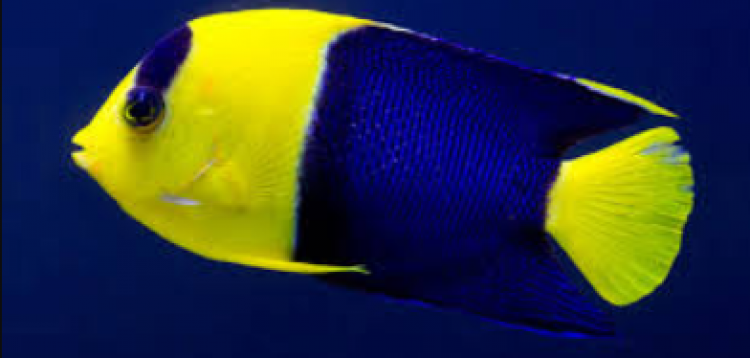- Name:
Blue Spotted Angelfish
(View AKA's) - Family: Angelfish
- Species: Angel Dwarf
- Scientific Name: Chaetodontoplus caeruleopunctatus


General info about Blue Spotted Angelfish
The Blue Spotted Angelfish, aka Blue-Spangled Angelfish is named as such due to the powder blue spots that cover its gray body. Its tail is yellow, and the anal and dorsal fins are edged in black. It is a reef-associated non-migratory species found in coastal reefs at fairly shallow depths ranging from 15 to 40 m.
Chaetodontoplus caeruleopunctatus can reach a maximum adult size of 6 inches. This species is collected for the aquarium trade but is rarely exported. It is a rare species known only from one specimen caught off Cebu Island in 1972.
Blue Spotted Angelfish Diet & Nutrition
C. caeruleopunctatus is known to be omnivorous, feeding on sponges and tunicates. In tank conditions, Blue Spotted Angelfishes may be fed with diatoms, spirulina, and other angelfish food preparations. Frozen food such as shrimp and other meaty nutrients can be added to their diet. Further, flake foods shuch as Nori may be added to their diet.
Feeding the Blue Spotted Angelfishes must be done at least 3 times a day to avoid nipping on soft corals or clam mantles.
Determining Sex of Blue Spotted Angelfish
All the members of the genus Chaetodontoplus are protogynous hermaphrodites which means that they change sex from female to male at sexual maturity or when the need arises. Size is a usual differentiating characteristic in protogynous hermaphrodites, where male a relatively larger than the female fishes.
Breeding & Spawning Blue Spotted Angelfish
Blue Spotted Angelfishes often grouped into harems with 1 dominating male individual and 3 to 4 female angelfishes. Courtship begins at dusk when male soars above the female, hovers with his fins extended, and tilts at a 45-90 degree angle from the bottom. When the female is ready to spawn, it follows the male and initiates spawning with a mutual soaring display.
The gametes are then released into the water column for external fertilization.
Common Diseases with Blue Spotted Angelfish
Angelfishes such as the Blue Spotted Angelfish might be able to contract common bacterial diseases such as Cotton wool disease, Vibrio bacterial disease, and Fish tubercolosis. Cotton wool disease is exhibited as an expanding translucent layer that eats away on the skin. Vibrio Bacterial disease on the other hand are exhibited by Dropsy, Popeye, Bleeding or Red Streaks on the skin. Lastly, Fish T.B. usually shows up as a loss of color and swelling of the body. It can also display blood streaks and blood spots anywhere in the body.
Aside from bacterial diseases, angelfishes my be affected by common reef scourges such as the Crypt or White Spot Diseases and Velvet Disease. Tiny white spots on the skin of the fish is one of the tell-tale sign of infection of the Crypt while dusty golden film on the skin or the eyes of the angelfish will detect the presence of Velvet Disease.
Blue Spotted Angelfish Origin
Blue spotted angelfishes are endemic in the reefs of the Philippines. However, it can be found to be distributed in the West Pacific Ocean.
Caution with Blue Spotted Angelfish
Depending on its tankmate it can be quite shy when first entering the aquarium and may hide in caves and crevices. Blue spotted angelfishes should be combined with other non-aggressive aquarium mates that has a calm character such as community fish like tangs, clownfish, damsels, gobies, blennies, butterflies and similar fishes. Smaller fish might get harassed when added with Blue spotted Angelfishes. Angelfishes should not be kept with other angelfishes in aquariums to avoid territorial conflicts. Species with same coloration should not be in the same aquarium.
It is best that they are kept in tanks 90-125 gallons in size to avoid the need to attack everyone that happens to swim by and to avoid nipping on hard and soft corals, and clam mantles.
Acclimating Blue Spotted Angelfish
The aquarium where the Blue Spotted angelfish will be kept should have sufficient hiding places and live rocks to hide in if they feel threatened. Acclimation time for this species is about 30 minutes. In adding the Blue spotted angelfish in an aquarium, the smallest and most docile individual should be added first followed by the largest and most aggressive individual. It may nip at soft corals, stony corals, and mantles of tridacnid clams, hence larger aquaria or fish only aquaria is recommended for these species.
Original Detail
| Name | Species | Family | Scientific Name | More Detail | Added by |
|---|---|---|---|---|---|
| Blue Spotted Angelfish | Angel Dwarf | Angelfish | Chaetodontoplus caeruleopunctatus | The Blue Spotted Angelfish, aka Blue-Spangled Angelfish is named as such due to the powder blue spots that cover its gray body. Its tail is yellow, and the anal and dorsal fins are edged in black. It is a reef-associated non-migratory species found in coastal reefs at fairly shallow depths ranging from 15 to 40 m. |
PalaciosAn |
Changed by users
| Submitted Date | Submitted By | Status | Action |
|---|




